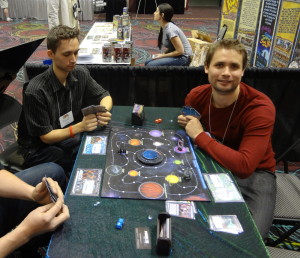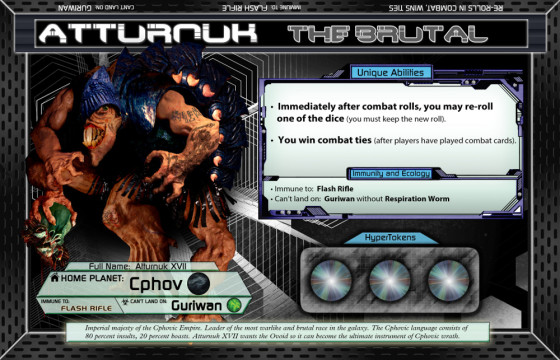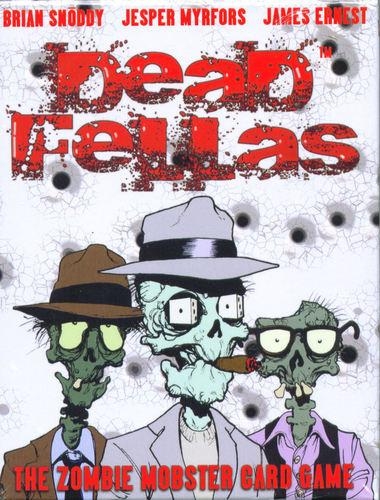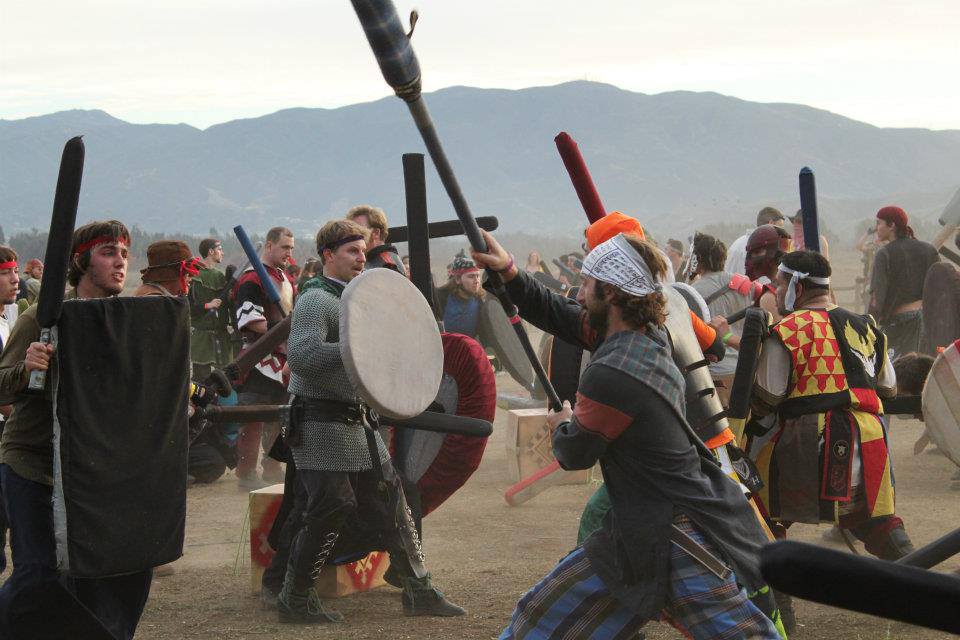Chasing the Ovoid: The Cosmic Goodness that is Chaosmos
 Currently on Kickstarter, Chaosmos is a cosmic chase played out via board game for the enigmatic Ovoid, a singular item of untold power. Produce the Ovoid card at the end of the game and you’re the winner, but along the way you’ll probably have to search planets, battle your foes with futuristic weaponry, and possibly even reverse time! Each player controls a unique alien race with its own set of powerful special abilities, as well as a hand of Equipment cards. By visiting a planet cards can be exchanged with those on the planet, represented in the game by an envelope. By paying attention to rivals’ interplanetary travels and opponents’ cards (revealed by being the victor in battle), shrewd players will begin to construct an understanding of their opponents’ strategies as well as possible locations of the Ovoid. If the Clue-like sleuthing isn’t enough to whet your appetite, Chaosmos features a 35mm miniature for each of its eight alien races as well as the Chaos Clock dial, which keeps track of game turns and can be reversed or sped up by use of the Temporal Displacer card, which can move the Chaos Clock forward or backward up to 8 turns!
Currently on Kickstarter, Chaosmos is a cosmic chase played out via board game for the enigmatic Ovoid, a singular item of untold power. Produce the Ovoid card at the end of the game and you’re the winner, but along the way you’ll probably have to search planets, battle your foes with futuristic weaponry, and possibly even reverse time! Each player controls a unique alien race with its own set of powerful special abilities, as well as a hand of Equipment cards. By visiting a planet cards can be exchanged with those on the planet, represented in the game by an envelope. By paying attention to rivals’ interplanetary travels and opponents’ cards (revealed by being the victor in battle), shrewd players will begin to construct an understanding of their opponents’ strategies as well as possible locations of the Ovoid. If the Clue-like sleuthing isn’t enough to whet your appetite, Chaosmos features a 35mm miniature for each of its eight alien races as well as the Chaos Clock dial, which keeps track of game turns and can be reversed or sped up by use of the Temporal Displacer card, which can move the Chaos Clock forward or backward up to 8 turns!
The great news is that Chaosmos has already met its $40,000 goal. I spoke with game designer Joey Vigour of Mirror Box Games the day after the game’s launch, on January 3, when the game had just reached 50% Funded and he revealed a wealth of information about Chaosmos’ development, strategy, and Stretch Goals.
The Development of Chaosmos
CG: Can you describe the process of the decision to Kickstart the game yourselves, because as I know, you had several serious nibbles from some game publishers at the GAMA Trade Show?
JV: Yeah, absolutely. We debuted our game at the GAMA Trade Show in March 2013 and our original goal was to meet a bunch of publishers and find out if the game was something that could compete in this current marketplace and it had original mechanics. We were pretty familiar with sort of the classic modern games, but we weren’t really sure if it was a marketable concept because it is pretty different from what’s on the market. We met with seven or eight different publishers at that show. We had lined up several interviews in advance and we met a couple people that let us pitch to them at the show. Three of the meetings went well and we followed up several times and there was some back and forth. One company actually requested that we develop the game with a completely different theme. But ultimately we just decided that this is a personal project so we really wanted to produce the game ourselves and the only aspect of producing the game that we didn’t think we could handle on our own was fundraising and so that’s why we decided to go with Kickstarter.
CG: Ok, now what was the theme that they were interested in?
JV: It was essentially a joke. I had jokingly said “Oh, and if you don’t like space then we could just make it pirates.” And they thought that was great and they wanted pirates, so instead of Hyperspace – which lets you teleport – they wanted Favorable Winds and you know… so it’s interesting.
CG: Yeah, I guess that in many ways it could still work. I don’t know about the countdown clock (Chaos Clock) and would they be chasing Davy’s Jones…?
JV: The Chaos Clock was going to be a Kraken. It was an interesting dalliance, but the honest truth is that I’m actually pretty married to the space theme. It’s a very personal theme for me; I love space. It was always conceived to be space. It was inspired by a bunch of different sci-fi books, especially one, Interstellar Pig, that’s a space book. It just seemed totally wrong to publish it with a pasted-on theme because so many mechanics are specifically designed secondarily to the theme and they work so well with the space theme. And so we were really stretching it. Why would you be able to remotely look at an island that was thousands of miles away in the pirate theme? It just wasn’t working; I didn’t like it. There wasn’t really a lot of money on the table anyways, so this was the right decision, to self-publish.
Early Origins of Chaosmos: Joey Vigour’s Childhood and an Interstellar Pig
CG: Right. So you mentioned conceiving the game, what was the original interstellar galactic event that spawned Chaosmos?
JV: I guess I would have to go back to my childhood. When I was a kid I designed a bunch of games and one of them was a paper-and-cardboard prototype called Interstellar Pig and it was inspired by a kids’ book [of the same name by William Sleator] that I still like to this day. Very rudimentary game. Roll and move, but the book was just great. Very inspirational. I thought a lot about space and a lot about the idea of flying around and looking for cosmic treasure essentially. So several game designs later, I ended up looking back at that prototype and reimagining it as a modern board game with an action point allowance instead of rolling and moving and a lot of, sort of, unique spins on existing mechanics and then some mechanics that I hadn’t seen before at all. So the initial game design started when I was a kid, but about two years ago, 2012 is when I buckled down and decided I was going to start working on this seriously. And it took about a year of development and then the past year since March has been almost exclusively putting my ducks in a row, building up to January 2, 2014 when we launched.
CG: Sure. Now have you read the sequel, Parasite Pig?
JV: Haha, I have read Parasite Pig; I think it’s terrible, haha. I’m not a fan of the sequel. I don’t think that it has the spark that the original has.
An Evolving Chaosmos
CG: You mentioned getting your ducks in the row, but what has changed about the actual game since the 2013 GAMA Trade Show in March? Have you changed anything about the game.
JV: Absolutely. I guess the primary advancement since that trade show is game balance and cutting down on player downtime, because when you playtest a game with friends and everyone knows all the cards there’s not a lot of analysis-paralysis. But when we actually took it to blind playtesting, we found that players really were uncomfortable making snap decisions that they didn’t fully understand the repercussions of taking certain cards versus other cards. There’s a lot of Race for the Galaxy style choices you have to make where you have a bunch of great cards and you have to discard some of them, or in this case, leave some of them behind on a planet. That just wasn’t working, for players to have to wait their turn, so to speak. So I would say the big change in the past nine months – and it’s a wonderful change – is that you’re now allowed to start your turn as soon as the previous player says he’s finished and he can continue adjusting his hand and the cards in his envelope and make changes between which cards are in his hand and his envelope even when it isn’t his turn. So that is a dramatic change. It allowed us to cut half an hour out of the gameplay and reduce the problems of analysis-paralysis to a negligible degree.
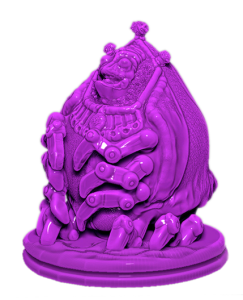 CG: Did any of the alien races change? Do they all still have the same names and the same unique game-breaking abilities?
CG: Did any of the alien races change? Do they all still have the same names and the same unique game-breaking abilities?
JV: We balanced the races more. That was a major change, because some aliens had amazing powers that were really powerful, but new players couldn’t figure out how to have fun with them, because they are basically really difficult powers. So we just tweaked everything until each alien now has basically a simple power and a more interesting or complex power. And so you can use both powers together in some cases or just the simple power. That was great. The alien names changed a lot in that they have really really long names, but we gave them nice, simple, memorable names. Like Vroon is pretty easy to remember. And Guriwan is a pretty easy to remember planet. Melphyuri-Ghorshi got shortened to Mel-Ghor, so a lot of positive changes in that way. It doesn’t hurt the gameplay at all obviously. Mel-Ghor’s the same planet and it’s called Melphyuri-Ghorshi by the aliens that inhabit it, but the galactic record books shortened the word [laughs] to Mel-Ghor.
CG: Now what’s the deal with this Homesick alien?
JV: Oh, the Haghouhen. Yes, so, he’s a very sad alien. He’s the last surviving member of his race. His planet was destroyed by comets and raided by Atturnuk’s race, the Cphovic Empire, so he’s the only one left. And he believes – maybe correctly, maybe incorrectly – that the Ovoid is the secret to reviving his race so he won’t be alone anymore.
CG: Ok. He’s kind of emo.
JV: Yes, he’s the emo alien.
CG: Now did you ever think of leaving some of these blank and then have as pledge levels on Kickstarter that backers actually name some of these things? How important are the names to you?
JV: Most of the names were created by my friend William Tombs. He also did most of the art, not the 3D renderings, but the art that the renderings were based on. And he is, in my opinion, like J.R.R. Tolkien. He has a whole world designed and he wants to make a bunch of games set in this universe: miniatures games and roleplaying games and novels. I think it’s great. I don’t think this particular game requires that amount of alien research in order to enjoy it. You can have Alien A, the Green Alien, or the Blue Alien or it could be like Cosmic Encounter where you have very simple alien names like Mirror, but I like a little bit of flavor. I think it is part of the overall experience and narrative as you play the game. When you remember particular sessions later, it’s more fun if you had an epic battle on the toxic planet of Atturnuk and Atturnuk reveals his Respiration Worm which is a worm that lets him breathe on Guriwan. It’s just more fun. It allows you to enjoy the game thematically as well as mechanically.
CG: Now any changes in the technology cards, the Equipment cards?
JV: There’s been some changes. One example is, there was a card called Cosmic Fear which forced your opponent to lay down all the combat cards that he was going to play all at once. That way you could decide whether you needed to waste that extra Ion Grenade in order to beat him or if you could save it. But that card ended up being too powerful, so it ended up being changed to a single-use card which goes to the Void after you’re done playing it. It was too powerful, because no card in the game should feel like a must-grab. Everything needed to be equivalent or equivalent in that they’re all good situationally. That was the biggest change, I would say, in the last six months, is weakening that card a little bit.
Mirror Box Games and Chaosmos at BoardGameGeek.Con
“BoardGameGeek.Con is a must-go. It was the greatest con I’ve ever been to.”
CG: I want to return to the must-grabs in a second. Changing topics just a little bit, what was BoardGameGeek.Con like for Mirror Box and what’s it like for the rest of us who have never been there? Tell us about it.
JV: BoardGameGeek.Con is a must-go. It was the greatest con I’ve ever been to. It was a convention for gamers; there was all sorts of gaming. I would walk around around and see Tom Vasel playing games with people that he’d just met at the table. I saw Rich Summer from Mad Men playing games. He’d walk by and sit down and he’d start playing a game. And he’s an actor, you know, and they’re not and no one cared. It was just amazing. We had a giant display in the main hall near the Hot Games section so we got a lot of traffic. Over a hundred people signed up to our email list and probably a 120 people played our game so almost everyone who played our game jumped on to our list. That’s a big deal. When you’re going to other conventions, a much smaller percentage of people are interested in backing your game later. We went to the right convention for our game.
CG: So at Gen Con, attendees buy tickets to play in events, does BoardGameGeekCon have a similar mechanic or do people just come and if there’s room they play?
JV: It’s expensive. It’s 80 or 90 dollars for the con, but you just walk into the board game library and they have every game ever and you check out whatever you want and hopefully you return it in a timely fashion and they don’t have to chase you down. And you play and you just play all day. And you can check out the Hot Games table(s) where all the cool games from Essen are being demoed. There’s a lot of prototypes. There’s a special section for prototypes and then there’s a lot of events, special events, that are going on. Unfortunately I didn’t get a chance to get outside of my exhibition hall that much, but it was just an amazing experience.
CG: Ok, so you definitely want to go again?
JV: I will go every year from now on.
CG: Ok. So how many demos and play tests do you think you’ve done now?
JV: Well, let me see. I would say it has definitely been, in the last year, we’ve probably played something like 1,000 sessions, because we had three and sometimes four copies of Chaosmos being demoed simultaneously at BGGCon for the entirety of the con. So, yeah, probably 1,000 games and quite a few blind play tests. We’re now testing a 5th-player expansion and we haven’t done our blind play tests for that at all. So that’s our next big hurdle, is to find the time to do blind playtesting with a fifth player.
CG: How many prototypes are there now?
JV: In this final version – we changed our board, that’s another change, that’s another thing that changed since the GAMA Trade Show is we reduced the number of stars between the planets – this version, there’s seven copies and they’re all checked out by reviewers right now. And there’s probably twenty prototypes. Then there’s three original prototypes where we 3D-printed the aliens and got them hand-painted. So hopefully we’ll get those all back. We used a company called Sculpteo for the 3D ones. And then all the other copies, as soon as I get those back I’ll probably chuck them because you never want to go back to your old version. The worst thing is when you show up to do a demo and you realize you packed the board from six months ago.
Must-Have Aliens, Equipment Cards, and Strategy
CG: You mentioned must-grabs and so on, is there a particular alien race that everyone seems to envy or want to play?
JV: A lot of new players like Atturnuk the Brutal because his miniature features a giant sword. A lot of people choose him. People who like backstory and who actually read the flavor text on the alien character sheets choose the Haghouhen a lot. A lot of people like Clokknid. They like robots for some reason. He’s a series of interlocking robots connected by an artificial intelligence that governs them all. A lot of people like that for reason.
CG: Has anyone started talking in a robotic voice for him?
JV: We have found that certain players do the voices and they do the voice from the moment they see the art for the character to the moment the game is done. That has been a strange experience. One guy is actually a voiceover artist. He was at our playtest we did just prior to the GAMA Trade Show in early March and he invented a voice for all eight aliens plus some other bonus aliens that we’re tweaking. And he recorded a little intro with all the different aliens. So I think we’re going to release alien profile videos using his various voices for the aliens. That’ll be fun.
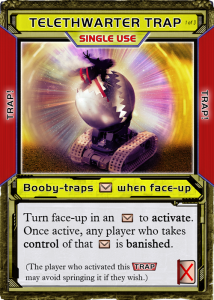 CG: The Equipment cards break down into Traps, Bases, Weapons and?
CG: The Equipment cards break down into Traps, Bases, Weapons and?
JV: So, yes, there are different types of Equipment cards. There’s Advanced Weapons; there’s Primitive Weapons. There are counters to all of the Advanced Weapons. Most of the cards are unique. There’s a 70 card deck and most of them are unique. There are Tactical cards which actually go face up on a planet. It could be face down just like any other card and you could take it into your hand and move it to another planet and come back for it later. But if you set it face up, then when another player lands on that planet, if he doesn’t have the Signal Jammer, he’s going to get trapped and the Trap would banish him back to his home planet and his turn would end. But there’s only three Traps in the game and they’re valuable, but you have to be careful how you use them, because they fill up your hand if you carry them around and then if you Trap a planet that doesn’t end up being important you’ve sort of wasted your time and your Trap. Vaults are interesting because they don’t protect a planet from prying eyes, in that if you land on a planet that’s Vaulted, you can still look at that envelope, but you can’t take anything. It’s a Magnetic Vault. You can’t take anything unless you reveal a Key. So you can hide the Ovoid on Pendra and if I land on Pendra I’ll announce “Ok, there’s a face-up card.” I’ll get to peak inside and see the Ovoid and I’ll know that you left it there and you’ll know that I know that it’s there, but if you hid the key on a different planet, then I’m gonna go on a mini-quest to find the Key, so I can come back and open the Vault. But by then, maybe you’ve figured out another way to get the Ovoid back. So a lot of second-guessing of what other people are doing. And then there’s also Bases that protect the envelopes with the combat cards that you store inside the Base.
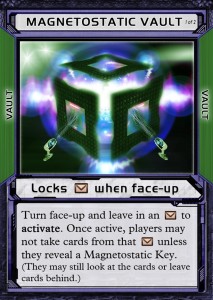 CG: So do some players forego playing Bases and Traps and just choose to play with Weapons? Is that viable? Are you able to play the whole game and beat it just choosing Weapons to use or can you be totally defensive and just collect Counters?
CG: So do some players forego playing Bases and Traps and just choose to play with Weapons? Is that viable? Are you able to play the whole game and beat it just choosing Weapons to use or can you be totally defensive and just collect Counters?
JV: This is, I think, the element of the game that I’m most proud of. People often ask, “What mechanic are you most proud of?” I think figuring out a way to the balance the game to a degree where we’ve yet to figure out an automatic game-winning strategy, that’s the thing I’m most proud of. Some players collect Weapons and Weapons are important because when you beat somebody in combat you get to look in their hand and take a card so that’s a way of discovering the Ovoid if somebody’s carrying it. If somebody isn’t carrying the Ovoid – if they’ve hidden it somewhere – you could beat them a hundred times and not get the card you need to win. Some players play with Vaults, they love setting Vaults up and deactivating the Vaults and moving them to other planets and then reactivating them. Some players like sticking all the Weapons they can get inside of their Base and then finding more Weapons and teleporting those Weapons into the Base using Hypertube cards. I personally think that the reason the game is so balanced in regard to strategies is the psychological element is more powerful than the mechanical element of which cards you have, because if I think that you are setting the Ovoid inside a Vault on Guriwan and I spend the game looking for something to break in there and steal it, and you’ve actually outsmarted me and you moved it earlier to a different planet that I hadn’t even thought of, then you’re going to win and I’m going to lose even though I might have all the Weapons in the world, and a Key, and a Signal Jammer that breaks Traps. It’s all about the Ovoid. It builds, and builds, and builds over the course of the game and it comes down to who has the Ovoid. So yeah, it’s a battle of wits.
Chaosmos Stretch Goals: Player Shields, Components, and Miniatures
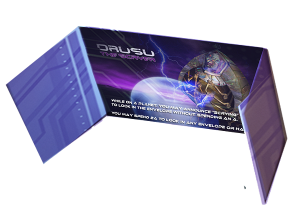 CG: So we’ll be talking about some other stretch goals in a bit, but what will players do if the Player Shields remain locked? What’s the role of the Player Shields?
CG: So we’ll be talking about some other stretch goals in a bit, but what will players do if the Player Shields remain locked? What’s the role of the Player Shields?
JV: When you’re opening a planet, first of all, it’s important that no one knows what cards are there. If you’re not sitting far enough away from the person to your left and right, there’s a chance if you’re not accessing your envelope under the table or off to the side that they could accidentally catch a glimpse of some of the cards. Anytime that you’re manipulating cards face up as well as face down, there’s the chance of accidentally revealing information and information is key in this game. Part of the concept of the Shields is it’s more just a matter of do players want them? Is it something that they want to tell their friends to back the project so that we can get to that level? I don’t think that it’s a critical game element; we’ve played the game for two years now without playing with Player Shields. We did make some recently as a test and it seemed like people were responding to it. It adds an element of three-dimensionality to the tabletop. Because you can look across the table and see what race I am and what my special abilities are quicker than just looking at my alien sheet.
CG: Ok. Onto some stretch goal stuff. Your first few stretch goals, can you explain the differences in components, between the 1.5 millimeter tokens and the 2 millimeter tokens?
JV: Sure, so, all of the Hyper Tokens are cardboard chits. So thickening them to two millimeters would be great because it makes them easier to pick up and it has some weight to it. I think it’ll be fun to thicken basically all of the cardboard in the game. In addition, there’s Landing Markers. Every time you land on a planet you’re going to be leaving your flag behind to remind people that you were there last. So all these 56 markers in the game – rather than just putting a thin sliver of a flag on a planet, it’ll be fun to have a nice, meatier meeple to leave behind.
CG: What can you think of that’s a comparable 2mm product?
JV: I don’t know the exact size of other games. Fantasy Flight uses a lot of 2mm cardboard in their expensive titles. Descent, Twilight Imperium. The flags in Twilight Imperium are great. So we want to upgrade components to that. Right now we’re working with Panda GM. In my opinion they make the best components in the industry. They make Merchants and Marauders and they make Eclipse: great component quality.
CG: So also for component quality, which is your second Stretch Goal, for the playing cards you have this upgrade from greycore to bluecore. Can you explain that to us?
JV: When I was a kid I had Magic cards that went through the washing machine and then dryer and you could still read them and play with them and those are bluecore. It’s a level of cardstock where there’s actually a core inside the paper which keeps it sturdy to a degree where you can play with the cards for years and years and years and they’re still playable, they’re still readable, they’re still in good quality. A lot of games, especially Kickstarter games, come out with greycore. It’s just a significantly lower quality paper. So greycore is still playable, it’s still great, but if you’re going to love a game and be proud to own it, you’re going to want to have bluecore because that’s the Magic: The Gathering quality.
The Chaosmos Miniatures
CG: Also, I’m always a fan of miniatures in board games, but how important are the minis to Chaosmos?
JV: I think it comes down to the thematic experience. It comes down to when you’re a kid and you play with miniatures it’s something that’s meaningful. I don’t remember any of the hex and counter games that I played when I was a kid. I mean I owned Starship Troopers and Diplomacy and I don’t really remember those games, but I remember the games that had miniatures, even the bad games with miniatures, so it comes down to does the game inspire the thematic in us? So I guess you could play the game with little pawns or cardboard player stands, but to me, it’s a miniatures game. It was always intended to be a miniatures game even when I was a kid. My brother, who is the primary sculptor in the family, would make little Play-Doh creations that we would put in the oven and we would play with those miniatures, so to me it really comes down to theme. The game is a thematic experience and my favorite thematic games all have miniatures.
CG: And why the 35mm scale?
JV: This is not a 4X game and you’re not going to be moving large armies around. You have a detailed, single alien that you are playing the role of. Warhammer 40K would use 28mm for the size of a figurine, but 35mm it gives it enough attention to detail so you can easily see that the blue alien has a bunch of extra arms and his special ability allows him to hold extra cards and Vroon the Adventurer has a jetpack and he can move an extra movement action. Each alien’s miniature relates to their special ability in a way that even kids who play the game, instantly remember what they’re special ability is because of the miniature. So the 35mm, the larger size miniature, I think, adds to the fun.
CG: If we can imagine, right now you’re sitting at 50 percent funded. Let’s say you were at 3 percent. Would you ever ditch the miniatures if you needed to?
JV: Well Kickstarter is an interesting thing because when somebody backs your project, they’re believing in you and you can’t undermine them later and say, “Well, we’re keeping your money, but we’re not going to give you what you backed for.”
CG: Right. So you’re saying that maybe that’s why they backed you in the first place, because they want the miniatures?
JV: I think it depends on the backer. I think the family and friends who backed the project really probably don’t care about what they get in the end. I think the important thing is keeping our word. If our Kickstarter was a disaster but we could maybe figure out a way to make it work, I think you can always relaunch a project, but I had total faith that the project was complete and the miniatures were a critical component of that and as long as we’re honest with people about why we love miniatures and the component quality of the final product… I think everybody who’s backed us, loves the miniatures. We haven’t had anybody really say that they wish they could have the game without miniatures.
CG: Yeah, don’t you have Kemet behind you in your video?
JV: Yeah, probably! I love Kemet. I just played Cyclades recently as well and those have awesome miniatures. To me, I would rather play either of those games over any hex encounter game even if it had superior mechanics. It just excites my mind for whatever reason!
CG: Right, I share that with you. It’s also exciting to see the miniatures in this. Of course, you also have Twilight Imperium back behind you and you must love those figures and those ships too.
JV: I love Twilight Imperium. I play it more than anyone I know on the internet. We played six or seven times last year. My goal is to play at least six times again in 2014 and I think I worked it out that if I play at least six times in 2014, it’s one fifth of one percent of all my free time.
Hyper Tokens, Strategic Advice, and Chaosmos’ Dice
CG: Is the number of Hyper Tokens you have public knowledge or would you shield that as well?
JV: No, that’s public knowledge and you only have three and you don’t get them again. So you wouldn’t be able to hide it even if you wanted to. Hyper Tokens are a very valuable resource. It’s sort of like when you’re out of other options and you’re like, “I got to get to that planet before he discovers my entire cache of weapons or he gets the Ovoid,” or something like that, then you can expend the Hyper Token. But it’s generally really dangerous to do that, because when you use one, it’s such a big deal. It’s an immediate red flag. So this is another way to deduce what’s going on in the game and why it’s not a complete fog of war, because when you Hyper Token over somewhere, you’re probably not bluffing that there’s something good over there. You might be; there might be an amazing, clever reason that you’re bluffing. Generally speaking it’s a red flag that something awesome is going down on that side of the map.
CG: So you can just discover right at the beginning of the game that you have the Ovoid, right?
JV: Absolutely. You might start the game with the Ovoid, but it doesn’t necessarily give you an advantage. In fact, in many ways it gives you a disadvantage. If you carry it with you, it just fills up your hand, it’s a completely useless card until the last turn. Not to mention the fact that if someone suspects that you have it, they are going to come after you in such an aggressive way, it will be hard for you to gather items on planets because there will be people trailing behind you. So having the Ovoid… I don’t think it’s an advantage at all in the early part of the game. In the mid-part of the game, yeah, it’s nice to know where the Ovoid is, but I personally don’t carry it with me because it’s just too dangerous. They’re so many super-powerful weapons that are only good for one battle – so most of the cards are permanent; they go back to your hand after you use them. But some cards, like there’s Nano Fabricators that duplicate weapons and there’s Ion Grenades that are +3 in combat, but then they’re discarded. So if you really want to, you can probably win any single combat just by using these special cards, but you have to be tactical as to which combat is the one that you really need to win, because losing combat in this game, it really doesn’t matter that much. The other person will take one of your cards. He’ll get stronger and you’ll get a little bit weaker, but then you’ll land on a planet and you fill up your hand again and move on. It’s not a big deal. But if he takes the Ovoid from you because he won a battle, that would be a critical battle.
 CG: What’s the Ovoid on the dice mean?
CG: What’s the Ovoid on the dice mean?
JV: So, it’s actually a Mirror. The Mirror mirrors the other die. If you roll a 3 and a Mirror, then that’s a 6. If you roll a 5 and a Mirror, that’s a 10. If you roll two Mirrors, then that’s Infinity and you would instantly win that battle.
CG: Oh wow. But do you get into Infinity +3 versus Infinity?
JV: No. Somebody asked me that. I don’t think that it’s ever happened. Maybe it’s happened once. But if you both roll Infinity then both players are immediately banished back to their home planets and their turn ends. I was thinking about this because I saw the movie The Avengers and at one point Thor’s hammer strikes Captain America’s shield and bad things happen. And I thought that was a pretty funny moment, so that’s what happens when both players roll Infinity.
CG: Ok. Alright. Good luck with Kickstarter!
JV: Thanks!
All game images and artwork copyright Mirror Box Games and used with permission.

